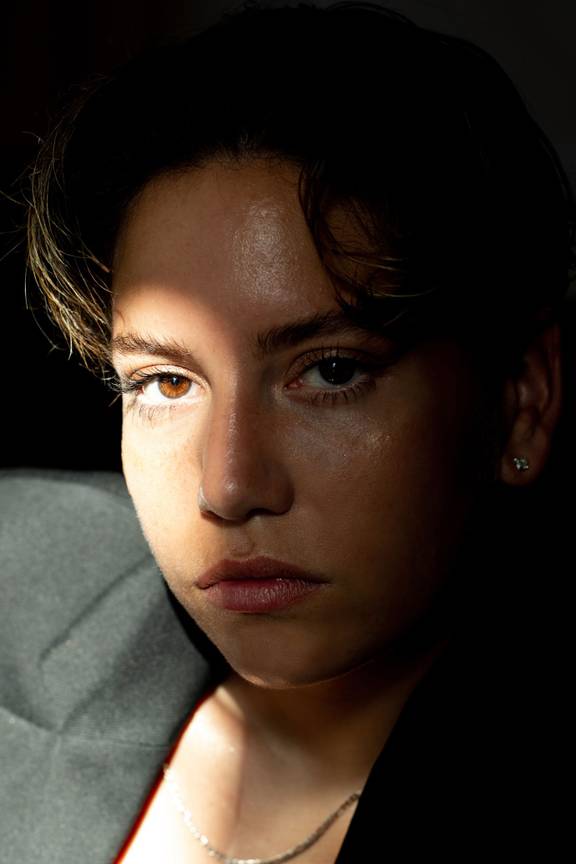Hip-hop dance champion, TikTok phenomenon, model for Adidas, and drag king in the intimate setting of Brussels cabarets. It is precisely because she is indefinable that Justine Theizen has the rare gift of bringing together worlds that were never expected to meet. The second edition of her battle All About Love does just that.

© Aubane Filée
Justine Theizen: ‘If you are queer and you want to dance hip hop, where do you go?’
If this interview had taken place one year earlier, Justine Theizen would have automatically identified with the pronoun “she”, because that’s what she had always done, because she had never asked herself the question before.
It was encountering the queer artists in the cabarets where she performs in Brussels as her masculine alter ego @zackthedrag that broadened her horizons: “That scene gave me the words to express the fact that I didn’t feel 100% like a woman. And that’s what led to me coming out as ‘gender fluid’.” Today, Justine Theizen, age 25, who has lived in Brussels for five months, feels as much like a “she” as a “they”. “Both pronouns are fine with me, I’ll let you choose which one to use in your article,” she informs us.
It was in a village in Brabant Wallon, far from the Brussels drag scene, that Justine Theizen’s career began to take root. As a teenager, watching videos by J.Lo, Snoop Dogg, 50 Cent and the choreographies they inspired on YouTube infected her with the hip-hop dance virus. Justine Theizen dances well, very well in fact.
So well that one of her hip-hop dance teachers invited her to join his crew in Brussels. Her destiny was transformed. The battles and choreography championships kept coming. The hip-hop community became her daily life, her rock, her family. And, since you don’t lie to your family, the dancer came out. She was fifteen.
Be the example
“I found myself dealing with a lot of unspoken things. The hip-hop scene is still, even today, very reserved when it comes to homosexuality and even sexuality more generally,” says the dancer. “If I sensed a kind of homophobia, it was never clearly articulated. People would ask me inappropriate questions. For example, they would ask who was the boy in the couple. Or I would be included in the men’s circle even though I wasn’t one. You might think that I had stopped being sexualised, but I still was. For ten years, I had to prove that I was more than a lesbian woman.”
Justine Theizen: “When I was dancing, I could be myself without having to justify myself.”
Faced with what she experiences as “micro-aggressions”, Justine Theizen built a tough shell, developed her style, refined her technique. “I asserted myself more and more in my hip-hop dance, which took on a more aggressive dimension.” Before long, krump, a type of street dance with African roots born in the ghettos of Los Angeles in the 2000s, emerged as the obvious choice. “Because it’s a very energetic dance that brings out a lot of emotions.” But by dancing krump and hip hop, Justine Theizen not only protected herself, she also gave free rein to her masculine side. Expressing her gender identity without restriction was a form of liberation. “When I was dancing, I could be myself without having to justify myself.”
Saddened by the lack of queer visibility within a hip-hop community that was nonetheless so close to her heart, Justine Theizen decided to be the example that had been so lacking in her life: a lesbian hip-hop dancer. Through humorous videos that are very popular on TikTok in which she dismantles stereotypes about lesbians (more than 75,000 followers). By modelling for inclusive campaigns by a big streetwear brand such as Adidas and a webshop like Zalando. By creating a dance show, POV : Nous sommes lesbiennes, which explores a romantic relationship between two women. And, finally, by organising a dance battle that unites the hip-hop and queer communities.
Peace, unity, love, and fun
“There are queer street dances such as voguing and waacking that belong to ballroom culture, a queer culture initiated by Afro-American transgender women (the club nights, catwalks, and competitions of ballroom culture had their heyday in the 1980s in Harlem, New York, ed.). But if you are queer and you want to dance hip hop, how do you go about it? Where do you go? Lesbians are stigmatised, but homophobia towards male dancers is still far more violent. And I won’t even go into what transgender people experience. We queer dancers must be able to have our place within the hip-hop community.”
The battle is called All About Love – “Because love is that warm feeling that helps you to reach out to the people around you and try to understand them.” After a sell-out first edition last year in the small hall of Le Jacques Frank, the battle will now take to the big stage. Queer dancers will face off against each other, fuelled by the energy of a supportive audience and by the values on which hip hop was founded: “Peace, unity, love, and having fun.”
Read more about: Podium